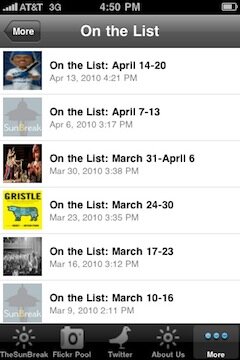Lorna Yee, local food lover
As I start posting reports about the local food scene as well as culinary escapes from Seattle, I thought it would be interesting to share a perspective on the sometimes hard-to-define Pacific Northwest cuisine.
I enlisted the help of Lorna Yee, a local food writer who just co-authored The Newlywed Kitchen: Delicious Meals for Couples Cooking Together. Yee has an adventurous appetite and is one of the people in Seattle I most trust for restaurant recommendations.
As someone who's lived in both Vancouver and Seattle and has spent time exploring the food scene in Portland, how would you define Pacific Northwest cuisine?
Pacific Northwest cuisine seems to center around salmon, shellfish, and foraged ingredients like fiddlehead ferns and morels. There's a bit of Asian influence, of course, though Vancouver chefs like Rob Feenie (ex-Lumiere), Seattle chefs like Tom Douglas, and Portland chefs like John Gorham seem to draw inspiration from around the world and apply it to the ingredients most readily found in their hometowns. There doesn't seem to be a "right" or "wrong" way to do things here—we don't have an almost religious (and admirable!) adherence to certain recipes and culinary traditions, like they do in the South. Chefs here are constantly innovating: there's no lack of creativity here in the Pacific Northwest.
Having recently moved to Seattle, how would you refine your definition of Pacific Northwest cuisine to make it more Seattle-specific?
Seattle is an incredibly green city that's focused on sustainability. Shopping at the farmers' market is routine for many of us here, and the "local, seasonal" mantra is not just one we see in restaurant kitchens. Many home cooks have adopted this way of cooking and eating in their kitchens, too.
What are Seattle restaurateurs and chefs doing well?
They are doing a great job of working with the reality that many of us are looking for a more laidback, more affordable dining experience nowadays. Casual sister restaurants, like Luc, or less formal options (like the bar/main dining room of Mistral Kitchen) ensure that restaurateurs are attracting larger clientele.
On the flip side, what's missing or done poorly here?
Asian food—with a few Eastside exceptions—is sorely lacking. Hopefully, with Bellevue's Din Tai Fung opening, we'll see more demand for higher quality Chinese food. I'm not an expert on Indian food, but Indian friends also tell me that they haven't found much excellent Indian food in Seattle proper.
What do you miss most about dining out in Vancouver?
I miss the Chinese food, first and foremost. There is such a wealth of deliciousness in Vancouver. Three of my favorite restaurants are: Empire Seafood (for Cantonese dim sum), Shanghai River (for Shanghainese food), and Alvin Garden in Burnaby for Hunanese food.
How would you characterize Chinese food in the Seattle area? Any particular likes or dislikes?
Chinese food in Seattle mostly caters to a Western palate. There is little regard to the traditional ingredients used in classic dishes. A well-regarded Sichuan restaurant in the International District, for example, substitutes American bacon and celery for bacon and leeks in the classic Hunanese dish—clearly a time and cost-saving tactic.
On a more positive note, I do love some of the cold case appetizer items at Spiced in Bellevue. They have one dish with slices of beef shank and tendon done in a spicy Sichuan peppercorn sauce that's incredible. It is a classic Sichuanese appetizer that's loosely translated as "Husband and Wife 'Lung' Slices"—not the most appetizing name, though rest assured that actual beef lung is rarely used.
Yee's recently published cookbook
There seems to be a fairly friendly rivalry between Seattle and Portland. You've had a chance to spend some time in Portland, sampling the food there. How is that scene different than the Seattle scene?
I adore the Portland food scene. I think the food is a little gutsier, and the scene a little grittier. One of my favorite izakayas, Tanuki, plays Japanese slasher porn videos in the dining room. You're digging into a plate of delicious duck and shitake salad with gingko nuts and drinking a milky-sweet Wataribune Namazake, while on TV, there are random body parts flying off, followed by geysers of blood. It is surreal. I try to keep my head down and concentrate on the food, but I admire the chef for sticking to her guns and not buckling to the pressure of patrons who are turned off by the way she runs her bar.
You've got a well-read blog, as one of many, many food bloggers in Seattle. What's the story with that? Why do you think there are so many food bloggers in this city?
Seattle is a very technologically savvy city—look at the number of us who use Twitter and Facebook! We have a thriving food community and want to share it all. It is natural to want to write about and photograph all the wonderful food we have here, from the plethora of vegetables at our farmers' markets to the number of excellent dishes we find in local restaurants. And of course, many of us enjoy documenting our own kitchen escapades!
What do you see as the trends in home-cooking here, and if you had the power, what would you like to see people doing more of in their kitchens?
Canvolution started right here in Seattle, so I have to give some local friends, food writers, and cookbook authors credit for helping to kick off the canning craze that's overtaken much of America. Personally, I'd like to learn more about fermenting my own foods—making kimchi, kombucha, and yogurts, for example.
Recently, I've been bit by the bread-baking bug. I've been pulling a lot of homemade loaves out of my oven—my current favorite is a pumpkin and raisin loaf that's incredible in a grilled cheese. It's hard for many of us to find the time to take on elaborate home-cooking projects with work, children, and social time with friends eating up valuable time. It would be a good thing if we all made small steps in eating less processed food and cooking more at home, though—even something as simple as roasting a chicken, and using the bones for stock will go a long way in teaching the next generation that cooking doesn't have to be a difficult chore.
You have a night off from restaurant reviewing, recipe testing, and anything else professionally related to food, and can eat what you wish. Assuming you don't have a tired stomach, what will you do for dinner?
I'd start the evening off with a pre-dinner cocktail at Zig Zag, then meander down to Spinasse for some ethereally light pasta. Then you'll find me at the bar at Harvest Vine for their housemade softly spiced blood sausage. (If I could be at two places at once, I might have to get a side of Tilikum Place Café's legendary porky baked beans too!) Next, Canlis has a remarkable dry-aged orange blossom honey roast duck for two. For dessert, there is no other place I’d rather be than at Mistral Kitchen, where pastry chef Neil Robertson churns out delicate, not-too-sweet treats like his seasonal rhubarb financier with fromage blanc and Szechuan peppercorn sorbet.
If I had to choose one restaurant, though, I'd pick Noodle Boat in Issaquah and put my fate in Toon's hands. My friends and I never leave without sampling fewer than ten dishes, all ordered off-the-charts spicy. The flavors are fresh, bright, and it's the only restaurant in town that makes me sweat. This is food I dream about.


 Subscribe to our Front Page Stories
Subscribe to our Front Page Stories
![]() Subscribe to all SunBreak Stories
Subscribe to all SunBreak Stories



Most Recent Comments